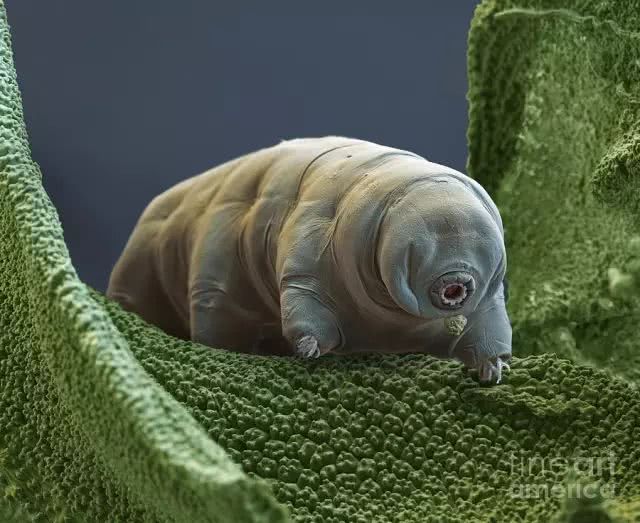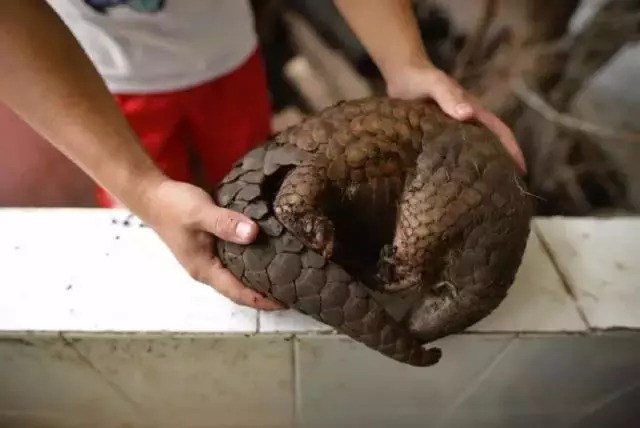Why does one real man in a thousand walk on his back?

Well, before I get to know the protagonist of today,
Let's first warn about insect bugs. _ (: insect "∠) _
If asked what is the largest group of organisms on earth, you would probably guess that it is some single-celled microbes.
If single-celled organisms are not considered, what kind of multicellular animals have the largest number of individuals? It's a nematode. Although you may not be able to say this answer, this group has produced a Nobel prize-winning experimental animal-beautiful hidden rod nematode Caenorhabditis elegans.
Yeah? What is a nematode? How beautiful is it now? How can you still win the Nobel Prize?
The beautiful hidden rod nematode under the microscope. Picture: kdfj / wikimedia
They're everywhere.
Caenorhabditis elegans belongs to the phylum of nematodes, which contains more than 25000 species of invertebrates. In a suitable environment, there may be tens of millions of nematodes living in every square meter. In terms of the number of individuals, 80% of the animals on earth are nematodes-animals around the world stand in line, and there are an average of four nematodes between you and the next "non-nematode."
A root-knot nematode is trying to get into the roots of tomatoes. Picture: William Wergin & Richard Sayre / Wikimedia
These creatures, which are usually paid little attention to, are the most widely distributed groups in the earth's biosphere, and can be seen at the poles, mountains, deserts and the bottom of the ocean. Nathan Cobb, a pioneer in American nematode taxonomy, once said that if everything but nematodes in the universe disappeared in an instant, then the nematodes floating in the void would be a replica of the earth's surface-mountains, lakes, towns and villages, and even trees and animals that might be able to restore their contours by distributing specific species of nematodes.
However, nematodes are not only "the strongest on the surface". In 2011, scientists discovered nematodes that feed on bacteria on the surface of a gold mine a few kilometers underground in South Africa. In addition, a considerable number of nematodes are parasitic, such as Ascaris lumbricoides, which we are most familiar with.
The diversity of the nematode phylum, in which an is an Ascaris lumbricoides and b is a beautiful hidden rod nematode. Photo: Blumenthal & Davis / Nature Genetics (2004)
Compared with the noodle roundworm, which can be up to 30 centimeters long, the beautiful hidden rod nematode is petite, with mature individuals no more than 1 mm long, with a pointed head and tail, with a cylinder that can bend freely in the middle. Its generic name Caenorhabditis contains the word "rhabditis", while the original name elegans means "beautiful and elegant". Take a look at the sinusoidal movement of the beautiful hidden rod nematode, and you will probably understand how this transparent and colorless "bug" got its name. In addition, unlike Ascaris lumbricoides, Caenorhabditis elegans is a nonparasitic nematode.
Beautiful hidden rod nematode "elegant" way forward. Picture: Bob Goldstein / wikimedia
Nematodes just lie down and walk.
Although the nematode is small, it has all the five internal organs. As an animal with three germ layers like human beings, the ectoderm of C. elegans develops into a "syncytial body" with multiple cell fusion, and it is the collagen secreted by this structure that forms the "skin" that covers the whole body. It is an "exoskeleton" that can shed and update as the worm grows. This is also one of the characteristics of the nematode phylum, indicating that they are closely related to the same molting arthropod phylum.
The arrow shows the "exoskeleton" formed by the fusion of different parts of the nematode's body. Picture: wormatlas.com
Below the cortex are four muscle bands formed by the mesoderm that run through the body, controlled by a set of interconnected nerve cells. Because of the way the muscles contract, what is seen in the motion picture is actually "bending" in the dorsal and ventral direction, so the normal beautiful hidden rod nematode is always walking on its side.
The muscle bundles of C. elegans were delineated by immunofluorescence staining technique. Picture: wormbook.org
On the inside of the muscle is a fluid-filled prosthetic cavity, followed by a straight digestive tract-behind the mouth is the pharynx with muscle cells that can crush food, and then the intestine; there is a small circle of circular cells in front and back of the intestine to form two "valves" that can be opened and closed, equivalent to our human cardia (the entrance to the esophagus) and the anus. The long gonads are attached to the digestive tract.
Only one in a thousand can have a "real man".
From a human point of view, the reproductive mode of Caenorhabditis elegans is relatively strange, which can be divided into "androgynous" and "male" sexes. The vast majority of individuals in normal growth groups are hermaphrodites: in the immature stage, hermaphrodites produce sperm and store them in the gonads; mature individuals produce eggs and combine with prepared sperm to form fertilized eggs.
The internal structure of a hermaphrodite. Picture: wormatlas.org
Hermaphroditism is strictly a female, with five pairs of autosomes and two X-sex chromosomes in the genome. The resulting sperm and eggs contain a set of five autosomes and one X chromosome, so most of the embryos produced by the combination are hermaphroditic (5x 2x).
However, there is a very small chance that a fertilized egg will randomly lose an X chromosome and develop into a male individual, which can be said to be one in a thousand "real men". Hermaphroditic self-insemination can produce about 300 fertilized eggs, while after hermaphroditic fertilization, the number of offspring can exceed 1000.
When a hermaphroditic male is in "close contact" with each other, the fan-shaped structure of the tail is used to find the gonad opening for insemination. Picture: Kbrugman / wikimedia
How to accomplish the three killings of the Nobel Prize
The most important identity of the beautiful hidden rod nematode is the scientific research model organism. In the 1950s, when biological genetics research was beginning to flourish, South African biologist Sydney Brenner made a great contribution to the development of molecular biology, but then he turned his interest to the neurodevelopmental mechanism of organisms. However, how to study the human nervous system, which is made up of 100 billion neurons? Brenner found the beautiful hidden rod nematode with special skills.
First of all, the beautiful hidden rod nematode is small, easy to eat, grows fast, and has strong vitality-after raising a layer of E. coli on the Agar plate commonly used in the laboratory, the nematode can eat happily and reproduce at the same time. At room temperature, it can reproduce in three or four days and live for about three weeks. The experimenter wants to have a holiday? No problem. Put the tablet directly into the refrigerator of-80 ℃, and thaw it when you come back after going out. The nematode is still alive. They can be easily passaged by hermaphroditic self-insemination, and the existence of males facilitates the hybridization of different genotypes.
In the middle of the petri dish is the E. coli colony, surrounded by a black circle of soil samples containing beautiful hidden rod nematodes (A); bacteria-feeding nematodes are attracted by food such as drilling out of the soil, and these active nematode individuals are singled out for next generation reproduction (B). Picture: Antoine Barri è re & Marie-Anne F é lix / wormbook.org
Secondly, the simple and complete body structure of nematodes is a good starting point for research. In 1983, British scientist John Sulston (John Sulston) studied the development of Caenorhabditis elegans. In the absence of advanced instruments, Sulston drew a map of the development of all the cells of the nematode by observing the transparent body with the naked eye under an optical microscope-from the first division of the fertilized egg. Each cell division of the nematode, the function and fate of each cell are completely determined. This is the first cellular developmental pedigree of multicellular organisms in the world.
The nerve cell body is represented by dots and the dendrites and axons of nerve cells are represented by lines. Scientists have drawn a nerve cell map of nematodes. Picture: The OpenWorm
Today, it is mentioned in almost all developmental biology textbooks that hermaphroditic nematodes produce 1090 cells during development, of which 131will start a normal apoptosis process and die, leaving only 959. In 2002, the Nobel Prize in Physiology and Medicine was awarded to Brenner, Sulston and Howard Robert Horvitz for their contributions to the regulation of organ development and programmed apoptosis. The nematode won a blood on the Nobel Prize list.
From the left are Brenner, Horwitz and Sulston, who unfortunately passed away in March 2018. Picture: nobelprize.org
Just four years later, the Nobel Prize in Physiology and Medicine was awarded to Andrew Fire and Craig Mello for elucidating the nematode's RNA interference mechanism-the discovery of organisms that can detect pathogen double-stranded RNA as a "guide" to attack the pathogen genome in a blank control group that never matched the expected results. Now, RNA interference mechanism has become a common tool in biological research. The nematode deserved to win the Nobel Prize.
Martin Charfi (Martin Chalfie), one of the three winners of the 2008 Nobel Prize in chemistry, used green fluorescent protein in the study of nematodes. The nematode completed the third kill of the Nobel Prize.
It was inserted into the beautiful hidden rod nematode, which encodes the green fluorescent protein gene. Picture: Dan Dickinson,Goldstein lab,UNC Chapel Hill
In fact, nematodes are more widely used in biological research. In 1998, through a "pre-experiment" of the Human Genome Project, Caenorhabditis elegans became the first multicellular organism in the world to be sequenced by the whole genome. By 2012, the nematode neural network, made up of 302 cell connections, had also completed the "connection group" test.
The elegant hidden rod nematode will continue to reveal the wonders of the mechanism of life for human beings.
Life is full of mysteries, like another universe. The picture shows the beautiful hidden rod nematode after fluorescent staining of the nucleus. Picture: queensu.ca
This is the 237th article in the fourth year of the species calendar, from @ Lupin, author of the species calendar.
If you like him, you can still follow him.
The magical creature of Lupin
Id: magic_bio
The magic of evolution creates magical hundreds of millions of creatures.
Online salon recommendation
If you encounter an injured bird on the way, do you want to take it home?
"pick up" abandoned animal cubs, who should be contacted?
Why, sometimes "save" wild animals but harm them?
Everyone must have a lot of doubts about wildlife rescue.
Come and listen to the online salon next Friday!
In this issue, Calendar Niang invited wildlife conservation workers.
@ wild youth Chen Laoxi
Solve questions and share stories for everyone
- Prev

The water bear bug may be the cutest dragon in Marvel movie history. Visual observation will dominate the screen for a week.
Li Li Niang went to see Ant Man 2 tonight. I know you haven't seen it yet, so I won't be a spoiler. However, knowing the following little thing is very helpful to watch the movie. Note: don't break into their territory, they are cute, but they really will.
- Next

Stop asking wild animals how to save them. All the answers you want are here.
People often ask Li Niang backstage: "I found an injured bird by the side of the road. What should I do?" "when I go out to play and meet an injured wild animal, who should I contact?" Although the calendar mother will tell you some Jane.
Related
- Wuhan Hospital Iron Tree Blooming Result Was Instantly Frightened by the Gardener Master
- Which variety of camellia is the most fragrant and best? Which one do you like best?
- What is the small blue coat, the breeding methods and matters needing attention of the succulent plant
- Dormancy time and maintenance management of succulent plants during dormancy
- Minas succulent how to raise, Minas succulent plant pictures
- What are the varieties of winter succulent plants
- How to raise succulent plants in twelve rolls? let's take a look at some experience of breeding twelve rolls.
- Attention should be paid to water control for succulent plants during dormant period (winter and summer)
- Watering experience of twelve rolls of succulent plants
- Techniques for fertilizing succulent plants. An article will let you know how to fertilize succulent plants.

